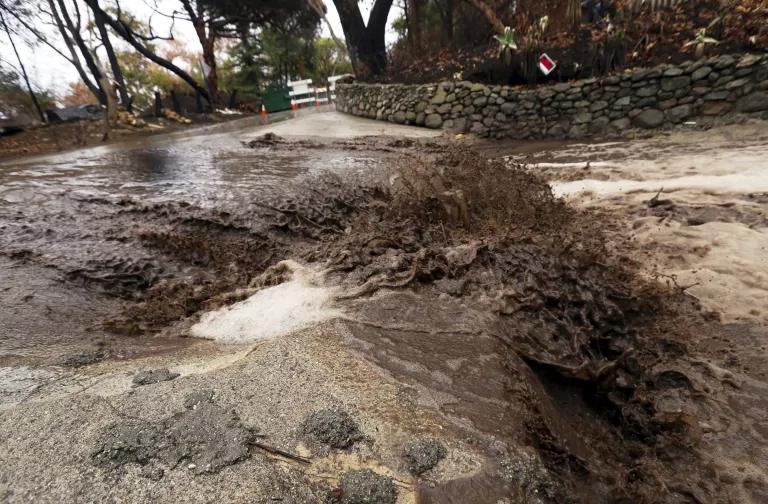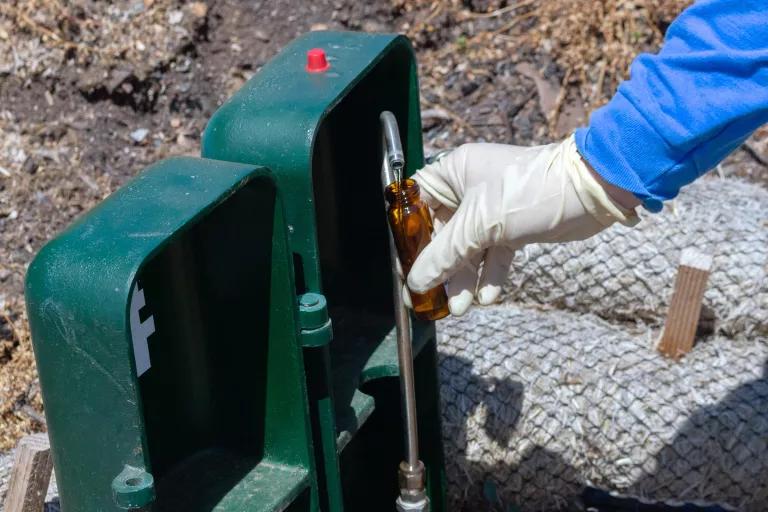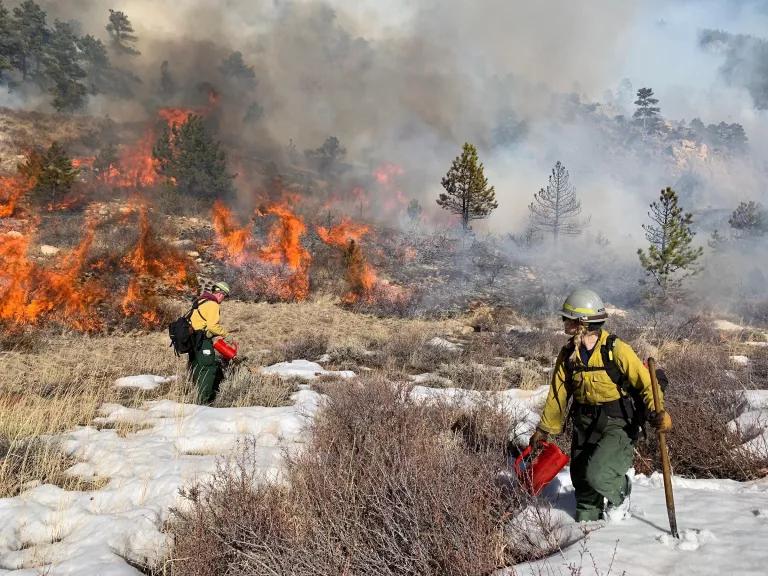Wildfires Can Spark Widespread Contamination of Public Water Supplies
In communities devastated by fires, scientists have found extremely high levels of toxic chemicals, like benzene, in tap water.

Rain falls on a home in Paradise, California, destroyed by the Camp Fire on November 22, 2018.
More than 8,300 blazes have scorched four million acres (and counting) in California this wildfire season—doubling the state’s previous record, set just two years ago. In addition to their rising frequency and severity, such fires are increasingly burning through residential areas throughout the West. This trend not only presents immediate dangers to the people living there but can have toxic consequences for the local water supply that can persist long after the smoke clears.
“Most people are not aware that when there are major wildfires, there is often some pretty serious water contamination,” says Erik Olson, NRDC’s senior strategic director for public health issues.
A study recently published in the journal AWWA Water Science found toxins, such as benzene and other volatile organic compounds, in the water distribution networks of areas hit by the Tubbs and Camp wildfires in 2017 and 2018, respectively.
The Camp Fire burned through California’s Butte County, destroying 18,800 homes and buildings and killing 86 people. In its aftermath, water samples in the Paradise Irrigation District showed benzene levels at 2,217 parts per billion (ppb). The federal limit for this cancer-causing compound in drinking water is just 5 ppb, and the legal limit in California is even lower at 1 ppb.
Other volatile organic compounds including naphthalene, toluene, and styrene were also present at levels exceeding federal safety standards, putting residents at risk for conditions ranging from irritated skin and nausea to more serious issues affecting the nervous, immune, and reproductive systems and impaired development in children. Further, long-term exposure to some of these chemicals, such as benzene, naphthalene, and styrene, are known or suspected to cause cancer.

Since 80 percent of the country’s freshwater supply originates on forestland, and thousands of communities rely on public water systems located in forested watersheds, anticipating various threats to water quality during and after wildfires is essential to protecting public health.
The Safe Drinking Water Act requires states to develop emergency drinking water plans for natural disasters. But “the plans are not as detailed as they need to be and are often not tested and not effective,” says Olson. “With climate change, we’re going to see more and more wildfires, and if we don’t have emergency water plans, people will be left high and dry.”
A Toxic Inferno
Pollutants can find their way into the water supply in several ways during and after a wildfire. The more obvious routes can be observed aboveground. “Wildfire creates dramatic changes to the landscape,” says Amanda Hohner, assistant professor of civil and environmental engineering at Washington State University and lead author of a 2019 study detailing the effects of wildfires on watersheds. “Burned soils, char, and ash . . . can flow downstream and into our surface waters, causing contamination.”
Some of the chemicals that firefighters spray on certain types of fires can also pollute nearby lands and waters. For example, per- and polyfluoroalkyl substances, known as PFAS, are commonly used to fight fires involving flammable liquids (such as gasoline). While the extinguishing foams doused on wildfires and structural fires do not typically contain PFAS, firefighters sometimes use them when fires enter communities and engulf gas stations, factories, and other industrial facilities.

Considered to be “forever chemicals,” PFAS from firefighting foam and many other industrial sources stay and spread in the environment for decades, even centuries, and have become a major contributor to drinking water contamination across the country. (A few weeks ago, California Governor Gavin Newsom signed a law designed to phase out the sale, manufacture, and use of PFAS-based firefighting foams in the state by 2022.)
Finally, scientists are learning more about how wildfires can compromise entire water distribution networks. High heat can degrade and melt plastic pipes, releasing dangerous compounds into the larger water system. This can happen when damaged plumbing leads to a drop in water pressure that essentially creates a vacuum, sucking soot and toxic chemicals into the pipes as the house or building burns.
“The Tubbs Fire was the first known discovery of widespread organic chemical contamination in a water distribution system, not just the source water, after a wildfire,” says Andrew Whelton, an associate professor of civil, environmental, and ecological engineering at Purdue University in Indiana. Over the course of 123 days, the Tubbs Fire destroyed 5,600 structures in northern California and killed 22 people.
After both the Tubbs and Camp Fires, water utilities replaced service lines, but the contamination persisted. The AWWA Water Science study, which Whelton co-authored, showed that of the 3,103 service lines tested, 11 percent contained water with benzene concentrations exceeding safety standards. In Santa Rosa alone, the cost to remove and replace contaminated components in the water distribution network after the Tubbs Fire exceeded $44 million.
An Ounce of Prevention
Whelton would like to see utilities take a proactive approach to safeguarding water supplies in high-risk areas. He thinks building codes that prohibit materials like plastic, that mandate the use of backflow prevention devices to keep contaminants from entering the drinking water system, and that require shutoff valves to be accessible to emergency crews and utilities would be a good start.
The preservation of old-growth forests is a strategy that can maintain their resilience to climate stressors like fire, insect infestations, and drought. Once logging or other industrial activity has compromised these forests, sustainable management can also help minimize the impact of wildfires on water supplies. Initiatives like Forests to Faucets, a partnership between the U.S. Forest Service, Natural Resources Conservation Service, Colorado State Forest Service, and Denver Water, aim to protect surface drinking water through techniques such as prescribed burns. Research out of the Colorado Forest Restoration Institute (CFRI) has found that mapping wildfire risk and then conducting burnout and fire line operations could lower wildfire risk to water sources by up to 55 percent.

“We think the effect lasts about 15 years,” says CFRI Director Tony Cheng of the wildfire management practices. He calls prescribed burning “one of our best and most effective tools” to prevent wildfires in the first place. But when big fires do occur, utilities must also take action to first protect water supplies and then effectively notify local communities about the potentially hazardous impacts on water quality.
Nearly two years after the Camp Fire, drinking water advisories remain in effect for many households in Butte County. But in a survey conducted six months after the disaster and despite warnings from the local health department, less than half of Paradise Irrigation District customers believed the fire had chemically contaminated their home’s water.
As scientists continue to gather evidence and as more wildfires burn through communities, 2020 will likely bring many more “Do not use” orders and advisories from local utilities. Some could remain in effect for years to come, leaving people without reliable access to safe water as they try to rebuild from the ashes.
This NRDC.org story is available for online republication by news media outlets or nonprofits under these conditions: The writer(s) must be credited with a byline; you must note prominently that the story was originally published by NRDC.org and link to the original; the story cannot be edited (beyond simple things such as grammar); you can’t resell the story in any form or grant republishing rights to other outlets; you can’t republish our material wholesale or automatically—you need to select stories individually; you can’t republish the photos or graphics on our site without specific permission; you should drop us a note to let us know when you’ve used one of our stories.
When Customers and Investors Demand Corporate Sustainability
How to Start Saving the Planet in 100 Days: the Joe Biden Edition
1.5 Degrees of Global Warming—Are We There Yet?